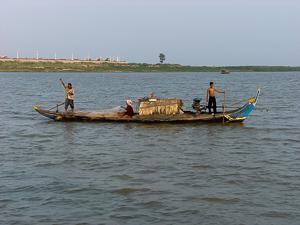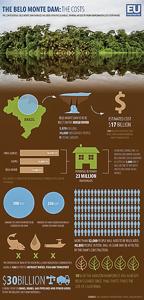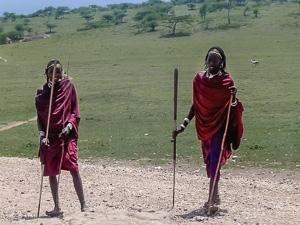
Imagine for a moment a lush forest. A canopy of green as far as the eye can see, shafts of light sprinkling through the trees, shifting with the wind, highlighting a small stream as they wind their way deeper into the forest. Birds call to one another, and animals shift through the underbrush. Closer examination reveals a small sliver of smoke working its way into the air, a subtle sign of human habitation. Now imagine that same forest, but changed. The lush canopy of the trees is replaced by a modern hotel, the previously subtle human presence is now the dominant feature of the landscape. The sounds of birds and animals are nothing but a memory. Unfortunately, this scene is becoming far too familiar around the world as countries turn their backs on the environment in favor of modernization and development. However, birds and animals aren't the only ones affected by these changes. One of the rarely covered side effects of development is the widespread displacement of indigenous people that precedes it.
For thousands of years, people have depended on their natural surroundings for their livelihoods, and it is only recently that mankind has moved away from this dependency. For many cultures, however, sustaining the environment in which they live and minimizing their impact on it remain necessities for survival. Yet these environments from which indigenous groups derive their existence often contain valuable resource. Thus it is these environments and people that are first targeted by government projects for modernization and revenue generation. When developers or government officials realize that profits can be made from the exploitation of local natural resources, they pass laws, sell land grants, and take other measures designed to drive out the indigenous people. With the land now vacant, developers build resorts, logging enterprises begin, and the government makes money off of what was once a protected environment. The displacement of indigenous peoples is a growing trend in the developing world, 
The Kuy of Cambodia serve as a perfect example of what happens when governments successfully displace the indigenous population inorder to develop "vacant" land. Much like many indigenous cultures around the world, the Kuy have a spiritual connection to their environment; they believe that spirits, Ah'met, dwell within the trees of the forest. These spirits, when pleased, promise good health and well being; when angered, they produce serious illness. It is important to the Kuyto maintain good relations with the spirits in order to ensure the health and prosperity of their families. To do so, they regulate how they collect medicines, sustenance and lumber, making sure to appease the spirits for each resource they use. Through these actions, the Kuy ensure long term biodiversity and sustainability.
As a country, Cambodia was plagued by genocide during thereign of the Khmer Rouge in the 1970s, as well as by widespread corruption and poverty. Recently, in a move to develop rural areas to help support the economy, there has been a focus on persecuting indigenous groups, driving them from their land and harassing those that support indigenous human rights. In 2011, the government continued its policy of granting large land concession for agricultural plantations, hydroelectric plants and mining, often in violation of community land rights. National laws require environmental impact studies and public consultations prior to development, but these are largely ignored, as are the laws forbidding the selling of forested areas. Specifically, the government has targeted the Prey Lang Forest, from which the Kuy derive their livelihoods, as an area requiring conservation. At the same time, local activists indicate that 40,000 hectares of land have been sold as rubber plantations, with an additional 27 licenses and concessions given to mining companies. Logging continues from concessions granted in 2002, and roads created to reach these tracts of land have taken their toll on the environment.

To make this project possible, developers will dig two 500 meter by 75 kilometer canals, and the dam itself will flood an area of 668 square kilometers (415 square miles). The flooding will displace up to 20,000 people from the Altamira and Vitoria do Xingu municipalities. This will restrict the livelihood of thousands and destroy hundreds of miles of rain forest that cannot be replaced; but this is only one aspect of this project. What is not widely publicized is that the dam, once completed, will only run at full capacity for approximately seven months per year when the river is at its peak. During the five-month dry season, the dam will only operate at 10 percent of its capacity. To compensate for this, the government will construct a series of larger dams on tributaries of the Xingu River. These additional dams will impact the indigenous territories of the Kayapo, flood the lands of the Arawete, Assurini, and Arara, and cause damage to the surrounding forest and local fisheries.
But not all such stories have sad endings. The Loita Maasi in Kenya continuously fight – often successfully – for their rights in the Naimina- Enkiyio Forest. Forests cover 1.4 million hectares of land inside the country, and these ecosystems are important to the national economy as sources of energy, catchment protection, medicine and other employment. The Naimina-Enkiyio Forest covers 330 square kilometers (approximately 205 square miles) but is unique in that it is one of the few land trusts controlled by indigenous peoples, the Loita Maasai, who have a spiritual and cultural connection to the area. They believe the responsibility to conserve the forest lies with them. For example, the Maasai understand the role of the forest as a water catchment for other water sources utilized by local communities, so they regulate grazing within the forest, limiting it to the dry seasons in order to keep it sustainable. What this demonstrates is an integral understanding of the environment within which they live and a dedication to managing natural resources sustainably.
In 2002, the Narok County Council of Kenya tried to take away the Loita Maasai stewardship of the land under the guise of creating a conservation park to protect the Naimina-Enkiyio Forest. In reality, the central government of Kenya sought to collect revenue from logging operations. At the same time, the Council sought to sell the remaining forest region to a consortium that wanted to build a tourist retreat, thereby destroying any hopes of preservation. The result of such maneuvers would deny the Maasai access to traditional medicines and sustenance, as well as culturally and spiritually significant areas and resources. This attempt was eventually stymied with the help of indigenous NGO groups in the area, but the question remains: what would have happened to the Naimina-Enkiyio Forest if the government had succeeded? The destruction of the environment and the displacement of the Loita Maasai were distinct possibilities and remain so as they struggle to maintain their claim to the land.

For generations, protection of the land was necessary for the survival of humankind. Relationships to the environment and consumption of resources were extremely important, but recent developments have revealed the change in this dynamic. While others are concerned with preserving the tradition of environmental sustainability and interdependence, others are more concerned with the wealth that such resources can bring to themselves or their country. Modern trends seem to favor the latter, and groups that once represented most of humanity are becoming ever scarcer. It is no longer inconceivable to imagine a world without such groups of people, without forests and freshwater. The question is: is modernization worth the price of the environment? That is a question each person must ask themselves and one without an easy answer.
All images are copyright protected and may not be used without permission. All photos are courtesy of Kathryn and Jonmikel Pardo. The graph is courtesy of Infrastructure EU and GDS Infographics and is used with the permission of Flickr CreativeCommons Attribution License 2.0 Generic.